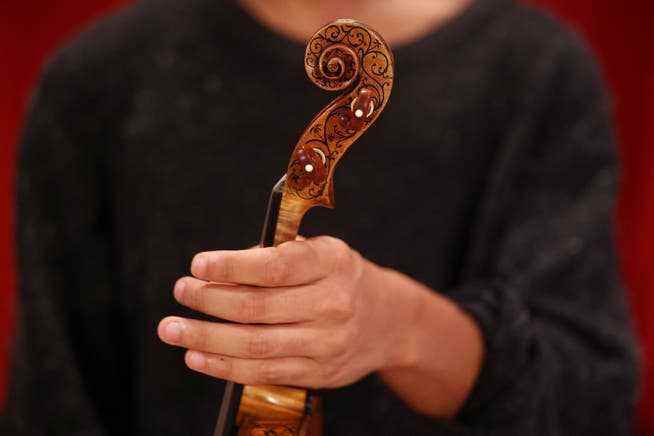A Stradivarius recently changed hands for more than $15 million. With the “Hellier” violin, another gem by the Italian master violin maker has now come under the hammer – and surprisingly stayed where it was.
Musician Braimah Kanneh-Mason plays the “Hellier” violin, which went on sale in London on July 7.
Graceful violin and swanky Porsche? You can’t put that together straight away. Nevertheless, Braimah Kanneh-Mason compares violins like the so-called “Hellier” by the Italian master violin maker Antonio Stradivari with a sports car. “You have to learn how to drive them first,” the violinist told Reuters, “but once you learn how to maneuver them, it’s incredibly rewarding.”
The 24-year-old Briton is one of the few who were allowed to play the “Hellier” personally. This Thursday it should become clear who will soon hold the violin in his hands: The instrument was offered for sale at Christie’s auction house in London.
The violin, dating from 1679, is considered a particularly rare example. Of the approximately 1,100 instruments that Stradivarius built over the course of his life, only around a dozen are adorned with decorations – and according to the curators of the American cultural foundation Smithsonian, this is the best-preserved example. A narrow band with diamonds and pearls surrounds the gold-orange shimmering surface, which is studded with almost 500 gemstones and ivory inlays. The frames and the scroll are decorated with elaborate ornaments.
The previous record is just under $16 million
Stradivari is said to have kept the violin for four or five decades, depending on the source. According to disputed family legends, the Italian himself sold his masterpiece to the musicologist Samuel Hellier from Wombourne, England, in the 1730s – allegedly for £40.
Today, a buyer would have to pay significantly more for the violin. Experts from the auction house Christie’s expected great interest in advance and an equally large proceeds: up to 11 million dollars.
But they were disappointed: when the violin was offered for sale late Thursday evening with a starting price of £5.5million, there was silence in the hall. When, after long minutes, neither the telephone nor the online interested party submitted a bid, the auction was closed without success.
The price would have been quite normal for the market: at the beginning of June, Stradivari’s violin “da Vinci, ex-Seidel” changed hands for 15.34 million dollars after a lively bidding process. The instrument, named after the American violinist Toscha Seidel, was only slightly below the previous record of almost 16 million dollars, which the famous “Lady Blunt” brought in in 2011.
Musicians can hardly ever afford such prices. Foundations or other patrons often lend them the prestigious violins. Thanks to a foundation, the Festival Strings Lucerne 2019 received the “Sellière” Stradivarius, which is said to have been in a Swiss bank safe for 40 years. This was only possible because the descendants of the long-standing owner decided against selling it at the market price.
Investment property Geige promises a secure return
Long overshadowed by wine, art or watches, historical instruments as investment objects are no longer an insider tip. A separate market has developed around their trade. The fact that the previous owner of the “da Vinci, ex-Seidel” according to “Zeit” was a Japanese businessman who made his fortune with fast-food restaurants could be interpreted as symbolic of this. In any case, connoisseurs are not surprised that in addition to private collectors, institutions that want to diversify their investments are also bidding.
“You won’t believe it, but the least important thing is the tone,” said Wolfgang Habermayer from the Vienna company Merito String Instruments Trust recently to “Zeit”. In individual cases, authenticity, condition and provenance play a role, but the rest is secondary. In other words: the naturally limited range of coveted pieces ensures good prices anyway. There are no major yield peaks like in other volatile markets, “but a very, very constant return,” confirmed Carlos Tomé, director of the auction house Tarisio, to Bloomberg. The general political and economic climate is contributing to this. “Whenever there was a war or a depression, the violins never suffered,” says Tomé. However, the boom also has its downsides: the business with valuable violins attracts fraudsters.

The delicately decorated scroll of the «Hellier» violin.
In view of this development, the failure is likely to have surprised the auction house Christie’s, which previously advertised the “Hellier” violin as the highlight of the program. It is conceivable that the legal provisions on the ivory with which the violin is decorated deterred potential buyers. To protect elephants, the EU tightened the rules for trade and imports at the beginning of 2022. It is true that special permits can be applied for for historical musical instruments. Nevertheless, Christie’s explicitly pointed out that objects made of elephant ivory could no longer be sent to the EU; it is the buyer’s responsibility to familiarize themselves with customs regulations.
It has also been shown earlier that not everything is possible in the instrument trade: Stradivari’s viola called “Macdonald”, which was offered in 2014 at a record price of 45 million dollars as an entry-level price, found just as few willing buyers as this week did the “Hellier ».
